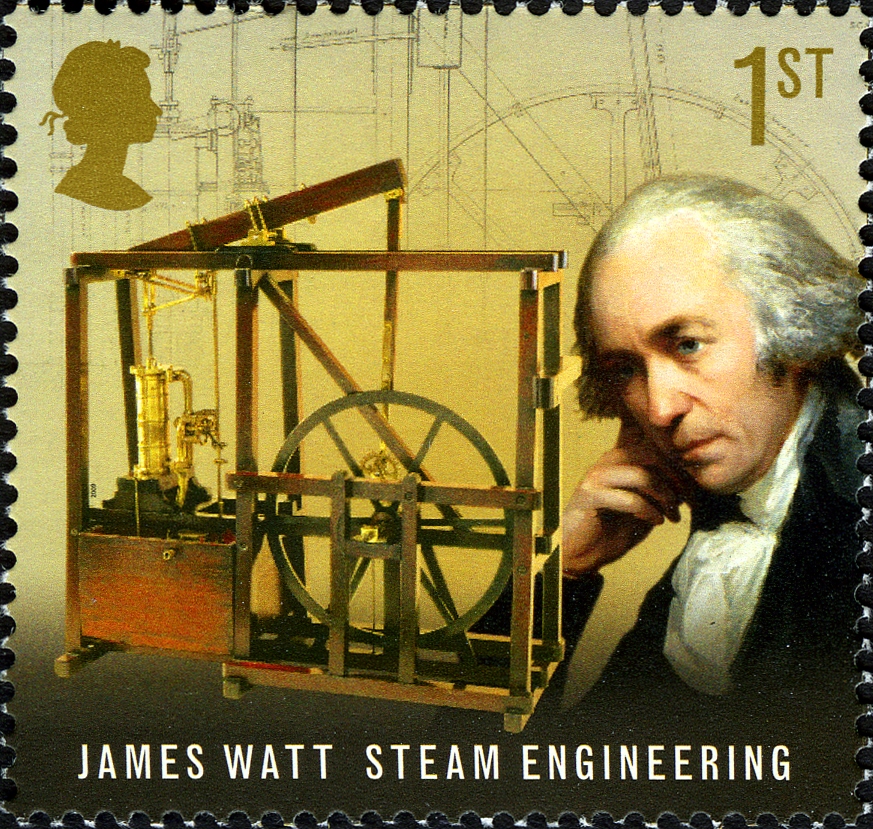Life path
James Watt was born on January 19, 1736 in Scotland, in Greenock near Glasgow. His father sent him to London so that James could learn plumbing. In one year, he mastered a 7-year program and, returning home, began working as a mechanic at the University of Glasgow. Having met the physicists J. Black and J. Robinson, Watt took part in their experiments to determine the heat of vaporization. At that time, it was very popular to create steam engines, among which by that time there were the “fire engine” of the Frenchman D. Papin, the steam water lift of T. Severi, and the steam-atmospheric engine of T. Newcomen. Watt begins to improve the steam engine.
James Watt was the first to ensure that the steam did not cool inside the cylinder, otherwise condensation would form and the efficiency of the machine would decrease. Watt’s machine used excess steam pressure, which improved efficiency and reduced the size of the installation (this feature was patented in 1768). The engineer’s work attracted the interest of manufacturer Matthew Bolton, who owned a metalworking plant in Soho near Birmingham, and he entered into a partnership agreement with Watt. In 1782, Watt created the first double-acting steam engine. Bolton had the idea to measure engine power in horsepower, and the unit of power was named after Watt – the Watt. Until the end of the century, the Bolton and Watt company was a monopolist in England in the production of steam engines.
Watt’s steam engine played a big role in the industrial revolution and the transition to machine production. In addition, Watt also owned other inventions and discoveries: a mercury manometer, water measuring glass in boilers, copying ink, and a pressure indicator. James Watt died on August 19, 1819 in Heathfield near Birmingham (England).
The role of the steam engine in economic development
Let’s look at the history of one invention, the steam engine, to see how innovation transformed more than just factory processes. First invented in 1712 by Thomas Newcomen, the steam engine was a cumbersome, slow and inefficient machine. Although it consumed an exorbitant amount of fuel, it still marked a breakthrough in making it possible to use coal, previously used only as a heat source, to create mechanical movement. Over the next 75 years, steam engines increased productivity in mining and blacksmithing, but were rarely used in factories because they were too weak and inefficient to replace water-lifting wheels. Then in the 1770s. James Watt improved the basic steam engine, making it much more efficient and capable of providing continuous and uniform rotational motion. The Watt engine became (literally) the main driving force in British factories in the 19th century. Then, starting in the 1830s, new and improved high-pressure engines appeared. Lighter and more powerful, these new engines were used not only in factories, but also in railroads, shipping, mining, military ships, and agricultural and construction equipment. In other words, the steam engine was not just a single, isolated invention, and its influence was not limited to factories alone. Rather, the uses of the steam engine continually multiplied and changed over the two centuries from 1712 to 1900, and factories were just one of the places where Watt’s invention contributed to changes in the economy.
It is important to understand what was truly revolutionary and what was a gradual adaptation of steam engines to industry and transportation. At its core, the steam engine was a unique breakthrough in human history, almost as important as the discovery of fire. Before steam engines, people relied on wind, water, and muscle power for everything that required mechanical energy. Burning coal or wood provided heat, but was useless for moving objects. The steam engine made it possible to use the burning of wood or coal to create mechanical motion, thereby enormously expanding the number of useful things that people could do with the help of fire. Fire was now not only a source of heat and light, but also mechanical energy for pumping water, lifting heavy loads, moving goods by land and water, and operating factory equipment.
The use of the steam engine in coal mines contributed to a dramatic increase in coal production at low prices, and the availability of cheap coal for fuel encouraged the spread of steam engines to all areas of the economy so that energy from coal could be used in all kinds of mechanical processes. Thus, the combination of steam engines and coal power made it possible to break down all the existing barriers to energy consumption in past societies. The eminent economist E. A. Wrigley called this change a transition from an organic economy (in which all energy was obtained from wind, water and living things) to an inorganic economy (in which energy sources became largely inorganic, mainly coal, but also oil and gas). This was one of the greatest transitions in human history.

But although the development of steam traction turned out to be revolutionary in its impact, it was not a one-time, sudden event. More precisely, more energy resources gradually became available as the steam engine was improved and applied to more and more activities; and such development took almost two centuries! In short, when we look back today and compare the use of steam engines (and trains and steamships) and the output of goods such as cotton cloth, iron and coal produced by steam engines in 1900 with what they had in 1700 g., we see that the Industrial Revolution is staggering in its scope and depth of impact. However, for people living in the 17th and 18th centuries, when these changes first began to occur, their progress was so slow that it was practically not felt by the majority of the population.
Just as the steam engine was used not only in factories, but also in mining, transportation and agriculture, a huge number of other innovations that revolutionized economic life occurred in areas that had nothing to do with factories. Here are just a few examples: the process of resurfacing roads with crushed stone has incredibly increased the speed and safety of horse-drawn vehicles. The use of iron in the construction of bridges and canals opened up new prospects for road construction and shipping. The invention of the telegraph changed the speed of communication in the 19th century. All these changes tied Britain together and allowed it to forge new connections with the rest of the world, making the movement of goods and messages faster and cheaper.
Thus, the emergence of industrial plants was only part of the massive changes in processes and technologies that transformed economic life in the two centuries after 1700.



